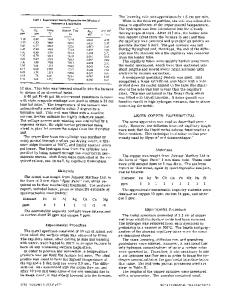Steady-State rates of dissolution of stationary iron, cobalt, and nickel cylinders in liquid copper
- PDF / 849,953 Bytes
- 10 Pages / 583.28 x 792 pts Page_size
- 66 Downloads / 283 Views
I.
INTRODUCTION
IN general,
the rates of dissolution of solids in liquids are proportional to the difference between the saturation concentration and the bulk concentration Of solute and are considered to be controlled by diffusion through the liquid in accordance with the Nernst equation. The Cu-Fe and Cu-Co systems exhibit great positive departures from ideality. For this reason the rates of dissolution of rotating iron cylinders in liquid copper and Cu-Fe alloys and of rotating cobalt cylinders in liquid copper and Cu-Co alloys were previously determined and the dependence of their dissolution rates on the thermodynamic activities as well as on the concentrations of the respective dissolving substances was investigated. 1-4 In the initial study on the Cu-Fe system, 1'2 the author proposed a rate equation in which the dissolution rate was proportional to the difference between the activities of iron at saturation and in the bulk. However, the validity of this equation could not be judged because the experimental data showed considerable scatter, and accordingly a further study 3 on the same system was carried out. The amount of scatter in the measured values of the dissolution rates in this study is much smaller than that in the initial study, and this study demonstrates that the dissolution rate is almost proportional to the difference between the saturation concentration and the bulk concentration of iron in the melt. In the study on the Cu-Co system 4 it was also found that there is a linear relation between the rate and the actual concentration of cobalt in the melt. Both studies suggest that the dissolution rates of rotating iron and cobalt cylinders in liquid copper are diffusion controlled. In the present study, the steady-state rates of dissolution of stationary iron, cobalt, and nickel cylinders in pure liquid copper and the liquid alloys of copper with the respective metals were determined as a function of their respective REIICHI OHNO is Associate Professor at The Research Institute for Iron, Steel and Other Metals, Tohoku University, Katahira, Sendai 980, Japan. Manuscript submitted April 30, 1981. METALLURGICAL TRANSACTIONS B
initial concentrations at various temperatures. The temperature dependence of the dissolution rates of iron and cobalt cylinders in pure liquid copper was determined. In every system investigated, the observed dissolution rate cannot be expressed by an equation in which the dissolution rate is expressed in terms of the solute concentration. The effect of the variation in the density of the melt with the solute concentration on the dissolution rate was considered on the basis of the expression of the mass transfer coefficient obtained from the analogy between heat and mass transfer. The activities of iron, cobalt, and nickel in liquid copper were calculated by more accurate methods than the previous ones)-4 and the relation between the dissolution rate and the activity of the solute was studied in each system. It was found in each system that the relation is linear and that t
Data Loading...











